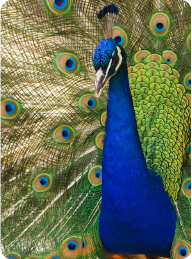 India Blue Peafowl
India Blue Peafowl
Pavo cristatus
Description
The peacock (male) is easy to identify due to his large size and long, ornate tail. The head and neck are a vibrant blue color, with white patches above and below the eyes. There is a fan-shaped crest of blue feathers on the top of the head. The body is gray with brown bars on the wings. Tail feathers are a metallic green color with blue and brown ocelli (“eye-spots”). These feathers are shed after the breeding period is over and grow back each year. Females (peahens) are drab in comparison. Their bodies are brown with white throats, green backs and necks, and pale abdomens. The crests of feathers on their heads are also brown. Peahens lack the long tails of the peacocks.
Size
Peafowl can weigh up to 13 pounds. They measure between 2.5 and 4.5 feet long, and the male’s tail can add an additional 5 feet of length.
Individual Animal Information
Cosley Zoo exhibits one peahen, which was received from a commercial hatchery, and hatched in 1998.
Adaptations
- A peacock’s most obvious adaptation is its long tail. The male uses his long, brightly colored tail to attract a mate.
- The drab color of the peahens helps them to camouflage while they are sitting on eggs.
- Peacocks have spurs on the back of their legs that can be used to defend themselves or their territories.
- Peafowl have 4 toes, 3 pointing forward and 1 pointing backward. This helps them to grab onto branches and roost in trees.
Diet
The peahen at Cosley Zoo receives birdseed as well as meal worms, fruits and vegetables.
Reproduction
The breeding season usually begins in March. Males may mate with several females in a season. The peacocks establish breeding territories in a common area called a lek. They display by shaking their characteristic trains to attract females. Peahens walk through the lek and choose a mate. After breeding, the female will lay 3-8 eggs and incubate them for 28 days until they hatch. The chicks are able to follow their mother around shortly after they hatch, and can fly up into the treetops after a few days.
Shelter and Space Needs
Although peafowl have been domesticated for many years, there are still wild members of the species living in India. They live in dense jungles near a water source. At night, they fly up into the trees to escape predators.
Life Expectancy
The life expectancy of wild peafowl is uncertain. In captivity, they can live up to 20 years.
Relationship with Man
India Blue Peafowl have been kept in captivity for over 2000 years. In ancient times, the possession of peacocks represented wealth. Today they are primarily kept for companion animals.
Fun Facts
- Peafowl are among the heaviest of the flying birds. Although they have the ability to fly, they generally prefer to run or walk. They only fly to escape predators and to reach the trees in which they nest at night.
- Peafowl are the national birds of India and are involved in Indian religious traditions.
- Many zoos do not cage peafowl. These birds will stay in one place as long as they have food, water, and somewhere to roost at night.
- Young peafowl are called peachicks.







